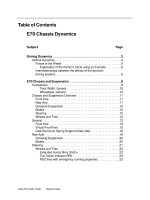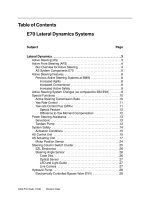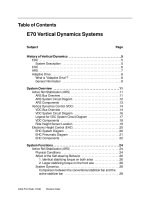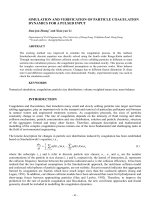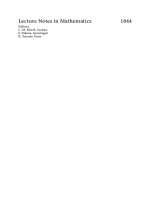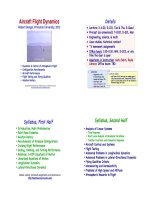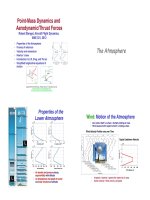AircrAircraft Flight Dynamics Robert F. Stengel Lecture5 Configuration Aerodynamics 1
Bạn đang xem bản rút gọn của tài liệu. Xem và tải ngay bản đầy đủ của tài liệu tại đây (1.65 MB, 13 trang )
Configuration
Aerodynamics - 1
Robert Stengel, Aircraft Flight Dynamics,
MAE 331, 2012
!
• Configuration Variables"
• Lift"
– Effects of shape, angle, and
Mach number"
– Stall"
• Parasitic Drag"
– Skin friction"
– Base drag"
Copyright 2012 by Robert Stengel. All rights reserved. For educational use only.!
/>!
/>!
Description of Aircraft
Configuration
Republic F-84F"
A Few Definitions"
Wing Planform Variables"
• Aspect Ratio"
• Taper Ratio"
λ
=
c
tip
c
root
=
tip chord
root chord
AR =
b
c
rectangular wing
=
b × b
c × b
=
b
2
S
any wing
• Rectangular Wing" • Delta Wing" • Swept Trapezoidal Wing"
Mean Aerodynamic Chord and
Wing Center of Pressure"
c =
1
S
c
2
y
( )
dy
−b 2
b 2
∫
=
2
3
#
$
%
&
'
(
1 +
λ
+
λ
2
1 +
λ
c
root
[for trapezoidal wing]
from Raymer!
• Mean aerodynamic chord (m.a.c.) ~ mean geometric chord"
• Axial location of the wings subsonic
aerodynamic center (a.c.)"
– Determine spanwise location of m.a.c."
– Assume that aerodynamic center is at
25% m.a.c.
"
from Sunderland!
Trapezoidal Wing"
Elliptical Wing"
Mid-
chord !
line!
Medium to High Aspect Ratio Configurations"
Cessna 337! DeLaurier Ornithopter! Schweizer 2-32!
• Typical for subsonic aircraft"
Boeing 777-300!
M
typical
= 75 mph!
h
max
= 35 kft!
M
cruise
= 0.84!
h
cruise
= 35 kft!
V
takeoff
= 82 km/h!
h
cruise
= 15 ft!
V
cruise
= 144 mph!
h
cruise
= 10 kft!
Low Aspect Ratio Configurations"
North American A-5A Vigilante"
• Typical for supersonic aircraft"
Lockheed F-104 Starfighter"
M
max
= 1.25!
h
ceiling
= 53 kft!
M
max
= 2!
h
ceiling
= 52 kft!
M
cruise
= 1.4!
h
creiling
= 50 kft!
Variable Aspect Ratio Configurations"
General Dynamics F-111!
North American B-1!
• Aerodynamic efficiency at sub- and supersonic speeds"
M
cruise
= 0.9!
M
max
= 1.25!
h
cruise
= 50 kft!
M
max
= 2.5!
h
ceiling
= 65 kft!
Sweep Effect on Thickness Ratio"
Grumman F-14!
from Asselin!
Reconnaissance Aircraft"
Lockheed U-2 (ER-2)" Lockheed SR-71 Trainer"
• Subsonic, high-altitude flight" • Supersonic, high-altitude flight"
M
cruise
= 3!
h
cruise
= 85 kft!
V
cruise
= 375 kt!
h
cruise
= 70 kft!
Uninhabited Air Vehicles"
Northrop-Grumman/Ryan Global Hawk" General Atomics Predator"
V
cruise
= 70-90 kt!
h
cruise
= 25 kft!
V
cruise
= 310 kt!
h
cruise
= 50 kft!
Stealth and Small UAVs"
Lockheed-Martin RQ-170"
General Atomics Predator-C (Avenger)"
InSitu/Boeing ScanEagle"
/>Northrop-Grumman X-47B"
Lifting Body Re-Entry Vehicles"
Northrop HL-10"
Martin Marietta X-24A"
Northrop M2-F2"
Martin Marietta X-24B"
JAXA ALFLEX" NASA X-38"
/> />Subsonic Biplane"
• Compared to monoplane"
– Structurally stiff (guy wires)"
– Twice the wing area for the same
span"
– Lower aspect ratio than a single
wing with same area and chord"
– Mutual interference"
– Lower maximum lift"
– Higher drag (interference, wires)
"
• Interference effects of two wings"
– Gap"
– Aspect ratio"
– Relative areas and spans"
– Stagger"
Aerodynamic
Lift and Drag
Longitudinal Aerodynamic Forces
and Moment of the Airplane"
Lift = C
L
q S
Drag = C
D
q S
Pitching Moment = C
m
q Sc
• Non-dimensional force
coefficients are dimensionalized
by "
– dynamic pressure, q"
– reference area, S"
• Non-dimensional moment
coefficients also
dimensionalized by "
– reference length, c!
Typical subsonic lift, drag, and pitching
moment variations with angle of attack"
Circulation of Incompressible Air Flow
About a 2-D Airfoil"
• Bernoullis equation (inviscid, incompressible flow)"
p
static
+
1
2
ρ
V
2
= constant along streamline = p
stagnation
• Vorticity"
V
upper
(x) = V
∞
+ ΔV (x) 2
V
lower
(x) = V
∞
− ΔV (x) 2
γ
2− D
(x) =
ΔV (x)
Δz(x)
• Circulation"
Γ
2− D
=
γ
2− D
(x)dx
0
c
∫
Lower pressure on upper surface"
What Do We Mean by
2-Dimensional Aerodynamics?"
• Finite-span wing –> finite aspect ratio"
AR =
b
c
rectangular wing
=
b × b
c × b
=
b
2
S
any wing
• Infinite-span wing –> infinite aspect ratio"
What Do We Mean by 2-
Dimensional Aerodynamics?"
Lift
3− D
= C
L
3−D
1
2
ρ
V
2
S = C
L
3−D
1
2
ρ
V
2
bc
( )
[Rectangular wing]
Δ Lift
3− D
( )
= C
L
3−D
1
2
ρ
V
2
cΔy
lim
Δy→ 0
Δ Lift
3− D
( )
= lim
Δy→ 0
C
L
3−D
1
2
ρ
V
2
cΔy
%
&
'
(
)
*
⇒ "2-D Lift" = C
L
2− D
1
2
ρ
V
2
c
• Assuming constant chord section, the 2-D Liftis
the same at any y station of the infinite-span wing"
For Small Angles, Lift is
Proportional to Angle of Attack"
• Unswept wing, 2-D lift slope coefficient"
– Inviscid, incompressible flow"
– Referenced to chord length, c, rather than wing area"
C
L
2−D
=
α
∂C
L
∂
α
$
%
&
'
(
)
2−D
=
α
C
L
α
( )
2−D
= 2
π
( )
α
[Lifting-line Theory]
• Swept wing, 2-D lift slope coefficient"
– Inviscid, incompressible flow"
C
L
2−D
= C
L
α
( )
2 − D
α
= 2
π
cos Λ
( )
α
Classic Airfoil
Profiles"
• NACA 4-digit Profiles (e.g., NACA 2412)"
– Maximum camber as percentage of chord (2)"
– Distance of maximum camber from leading
edge, (4) = 40%"
– Maximum thickness as percentage of chord (12)"
– See NACA Report No. 460, 1935, for lift and drag
characteristics of 78 airfoils"
NACA Airfoils!
/>!
• Clark Y (1922): Flat lower surface, 11.7%
thickness"
– GA, WWII aircraft"
– Reasonable L/D"
– Benign computed stall characteristics, but
experimental result is more abrupt"
Fluent, Inc, 2007!
Clark Y Airfoil!
/>!
Relationship Between
Circulation and Lift"
• 2-D Lift (inviscid, incompressible flow)"
Lift
( )
2 −D
=
ρ
∞
V
∞
Γ
( )
2 −D
1
2
ρ
∞
V
∞
2
c 2
πα
( )
thin, symmetric airfoil
[ ]
+
ρ
∞
V
∞
Γ
camber
( )
2 −D
1
2
ρ
∞
V
∞
2
c C
L
α
( )
2 −D
α
+
ρ
∞
V
∞
Γ
camber
( )
2 −D
Talay, NASA SP-367!
• Positive camber"
• Neutral camber"
• Negative camber"
Göttingen 387!
NACA 0012!
Whitcomb!
Supercritical!
Aerodynamic Strip Theory"
• Airfoil section may vary from tip-to-tip"
– Chord length"
– Airfoil thickness"
– Airfoil profile"
– Airfoil twist"
• Lift of a 3-D wing is found by integrating 2-D lift
coefficients of airfoil sections across the finite span"
• Incremental lift along span"
Aero L-39 Albatros!
dL = C
L
2− D
y
( )
c y
( )
qdy
• 3-D wing lift"
L
3− D
= C
L
2− D
y
( )
c y
( )
q dy
−b/2
b / 2
∫
Effect of Aspect Ratio on Wing
Lift Slope Coefficient
(Incompressible Flow)"
• Airfoil section lift
coefficients and
lift slopes near
wingtips are lower
than their
estimated 2-D
values"
Talay, NASA SP-367!
Effect of Aspect Ratio on
3-Dimensional Wing Lift
Slope Coefficient
(Incompressible Flow)!
• High Aspect Ratio (> 5) Wing"
C
L
α
∂C
L
∂
α
#
$
%
&
'
(
3−D
=
2
π
AR
AR + 2
= 2
π
AR
AR + 2
#
$
%
&
'
(
• Low Aspect Ratio (< 2) Wing"
C
L
α
=
π
AR
2
= 2
π
AR
4
#
$
%
&
'
(
All wings at M = 1!
Bombardier
Dash 8!
Handley Page HP.115!
Effect of Aspect Ratio on 3-D
Wing Lift Slope Coefficient
(Incompressible Flow)"
• All Aspect Ratios (Helmbold equation)"
C
L
α
=
π
AR
1+ 1+
AR
2
#
$
%
&
'
(
2
)
*
+
+
,
-
.
.
HL-10!Q400!
For Small Angles, Lift is
Proportional to Angle of Attack"
Lift = C
L
1
2
ρ
V
2
S ≈ C
L
0
+
∂
C
L
∂α
α
%
&
'
(
)
*
1
2
ρ
V
2
S ≡ C
L
0
+ C
L
α
α
%
&
(
)
1
2
ρ
V
2
S
where C
L
α
= lift slope coefficient
• At higher angles, "
– flow separates"
– wing loses lift"
• Flow separation
produces stall"
/>Aerodynamic Estimation
and Measurement
Handbook Approach to
Aerodynamic Estimation!
• Build estimates from component effects"
– USAF Stability and Control DATCOM (download at
/>)"
– USAF Digital DATCOM (see Wikipedia page)"
– ESDU Data Sheets (see Wikipedia page)"
Interference
Effects
Interference
Effects
Wing
Aerodynamics
Fuselage
Aerodynamics
Tail
Aerodynamics
Interference
Effects
• NASA 30 x 60 Tunnel"
– Full-scale aircraft on balance"
– Sub-scale aircraft on sting"
– Sub-scale aircraft in free flight"
– Maximum airspeed = 118 mph"
– Constructed in 1931 for $37M (~
$500M in todays dollars)"
– Two 4000-hp electric motors"
Wind Tunnel Data!
Blended Wing-Body Model in Free Flight!
/>!
Full-Scale P-38!
Sub-Scale Learjet!
Sub-Scale F/A-18!
/>Wind Tunnel Force and Moment Data!
Three-Strut Mount!
Single-Strut Mount!
Sting Balance!
High-Angle-of-Attack !
Sting Balance!
Texas A&M!
NACA Free Flight Wind Tunnels"
• Test section angle and airspeed adjusted to gliding flight
path angle and airspeed"
12-ft Free Flight Wind Tunnel!
/>5-ft Free Flight Wind Tunnel!
Model in 12-ft Free-Flight Tunnel!
/>Interpreting Wind Tunnel Data!
• Wall corrections, uniformity of the
flow, turbulence, flow recirculation,
temperature, external winds (open
circuit)"
• Open-throat tunnel equilibrates
pressure"
• Tunnel mounts and balances: struts,
wires, stings, magnetic support"
• Simulating power effects, flow-
through effects, aeroelastic
deformation, surface distortions"
• Artifices to improve reduced/full-
scale correlation, e.g., boundary layer
trips and vortex generators"
Full-Scale F-84!
Full-Scale P-51 Fuselage!
Sub-Scale !
Supersonic Transport!
Computational Fluid Dynamics!
• Strip theory"
– Sum or integrate 2-D airfoil force
and moment estimates over wing
and tail spans"
• 3-D calculations at grid points"
– Finite-element or finite-difference
modeling"
– Pressures and flow velocities (or
vorticity) at points or over panels of
aircraft surface"
– Euler equations neglect viscosity"
– Navier-Stokes equations do not"
Aerodynamic Stall, Theory and Experiment"
Anderson et al, 1980!
• Flow separation produces stall"
• Straight rectangular wing, AR = 5.536, NACA 0015"
• Hysteresis for increasing/decreasing α!
Angle of
Attack for
C
L max
!
Maximum Lift of
Rectangular Wings"
Schlicting & Truckenbrodt, 1979!
Aspect Ratio"
Maximum"
Lift "
Coefficient,"
C
L max
!
ϕ
: Sweep angle
δ
: Thickness ratio
Maximum Lift of Delta Wings with
Straight Trailing Edges"
δ
: Taper ratio
Aspect Ratio"
Angle of Attack
for C
L max
!
Maximum Lift "
Coefficient, C
L max
!
Aspect Ratio"
Schlicting & Truckenbrodt, 1979!
Large Angle Variations in Subsonic
Lift Coefficient
(0° <
α
< 90°)"
Lift = C
L
1
2
ρ
V
2
S
• All lift coefficients
have at least one
maximum (stall
condition)"
• All lift coefficients
are essentially
Newtonian at high
!"
• Newtonian flow:
TBD"
Flap Effects on
Aerodynamic Lift"
• Camber modification"
• Trailing-edge flap deflection
shifts C
L
up and down"
• Leading-edge flap (slat)
deflection increases stall α
"
• Same effect applies for
other control surfaces"
– Elevator (horizontal tail)"
– Ailerons (wing)"
– Rudder (vertical tail)"
Subsonic Air Compressibility and
Sweep Effects on 3-D Wing Lift Slope"
• Subsonic 3-D wing, with sweep effect"
C
L
α
=
π
AR
1+ 1+
AR
2 cos Λ
1 4
$
%
&
&
'
(
)
)
2
1− M
2
cos Λ
1 4
( )
+
,
-
-
-
.
/
0
0
0
€
Λ
1 4
= sweep angle of quarter chord
Supersonic Compressibility Effects on
Triangular Wing Lift Slope"
• Supersonic delta (triangular) wing"
C
L
α
=
4
M
2
− 1
Supersonic leading edge"
C
L
α
=
2
π
2
cot Λ
π
+
λ
( )
where
λ
= m 0.38 + 2.26m − 0.86m
2
( )
m = cot Λ
LE
cot
σ
Subsonic leading edge"
€
Λ
LE
= sweep angle of leading edge
Supersonic Effects on Arbitrary Wing
and Wing-Body Lift Slope"
• Impinging shock waves"
• Discrete areas with differing M and
local pressure coefficients, c
p!
• Areas change with α!
• No simple equations for lift slope"
Schlicting & Truckenbrodt, 1979!
Wing-Fuselage Interference Effects"
• Wing lift induces"
– Upwash in front of the wing"
– Downwash behind the wing, having major effect on the tail"
– Local angles of attack over canard and tail surface are modified,
affecting net lift and pitching moment"
• Flow around fuselage induces upwash on the wing, canard,
and tail"
from Etkin!
Aerodynamic Drag"
Drag = C
D
1
2
ρ
V
2
S ≈ C
D
0
+
ε
C
L
2
( )
1
2
ρ
V
2
S
≈ C
D
0
+
ε
C
L
o
+ C
L
α
α
( )
2
%
&
'
(
)
*
1
2
ρ
V
2
S
Parasitic Drag"
• Pressure differential,
viscous shear stress,
and separation"
Parasitic Drag = C
D
0
1
2
ρ
V
2
S
Talay, NASA SP-367!
Reynolds Number and Boundary Layer"
Reynolds Number = Re =
ρ
Vl
µ
=
Vl
ν
where
ρ
= air density
V = true airspeed
l = characteristic length
µ
= absolute (dynamic) viscosity
ν
= kinematic viscosity
Reynolds Number,
Skin Friction, and
Boundary Layer"
• Skin friction coefficient for a flat plate"
C
f
=
Friction Drag
qS
wet
where S
wet
= wetted area
C
f
≈ 1.33Re
−1/ 2
laminar flow
[ ]
≈ 0.46 log
10
Re
( )
−2.58
turbulent flow
[ ]
• Boundary layer thickens in transition,
then thins in turbulent flow"
Wetted Area: Total surface area of the
wing or aircraft, subject to skin friction"
Typical Effect of Reynolds
Number on Parasitic Drag"
from Werle*!
* See Van Dyke, M., An Album of Fluid Motion,
Parabolic Press, Stanford, 1982"
• Flow may stay attached
farther at high Re,
reducing the drag"
Effect of Streamlining on Parasitic Drag"
Talay, NASA SP-367!
Some Videos"
• Flow over a narrow airfoil, with
downstream vortices"
/> />• Flow over transverse flat plate, with
downstream vortices"
/>• Laminar vs. turbulent flow"
/>• Supersonic wind tunnel Schlieren
imaging demonstration"
More Videos"
• YF-12A supersonic flight past the sun"
• Supersonic flight, sonic booms"
• Smoke flow visualization, wing with flap"
• 1930s test in NACA wind tunnel"
/> />v=gWGLAAYdbbc&list=LP93BKTqpxbQU&index=1&feature=plcp!
/> />Next Time:
Configuration
Aerodynamics – 2
Reading
Flight Dynamics, 84-103
Virtual Textbook, Part 4,5
